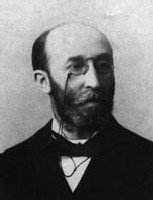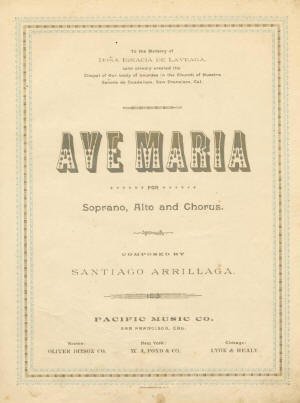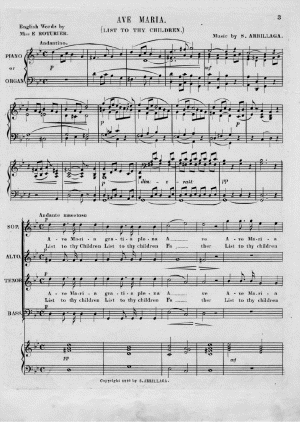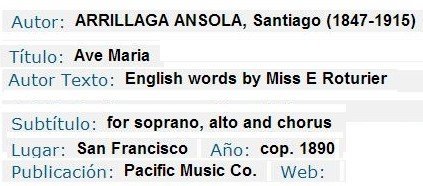Arrillaga, Santiago - Ave Maria
 for sopr. and alto solos and SATB chorus and organ
for sopr. and alto solos and SATB chorus and organ
 |
Composer:
Santiago Arrilaga (1847-1915) aliases, aka: Santiago Arrillaga y Ansola Country of origin / activity: Spain / USA |
|
| Text author: traditional | ||
| Arranger / Editor: N/A |
Available documentation:
Score: courtesy of http://www.mip.berkeley.edu/ |
 |
Lyrics: (source)
| not available |
| MIDI: not available | MP3: not available |
| Play / stop MIDI |
| Recording: |
| not available |
Video - posted on YouTube:
| not available at this time | YOU could be featured here! If you or your choir perform this Ave Maria, make a video recording. Post your video on YouTube, email me the page URL and I'll embed the video in this page. |
Internet references, biography information:
| A Hundred Years of Music in America |
The subject of this sketch was born in 1 847 at Tolosa in the province of Guipuzcoa and at the age of ten years he began the study of music in the old Spanish fashion with a solfeggio master who employed no instrumental accompaniment whatever In the course of a year he had fully mastered all that could be taught him by his instructor He then began the study of the piano as a recreation his teacher being DC Aguayo organist of the parish church He attended school both in Spain and France until the age of sixteen when having decided to pursue musical art as a profession he was sent to the Royal Conservatory at Madrid where he became the pupil of Don M Mendizabal in piano Don R Hernando in harmony and Dr H Eslava in counterpoint At the close of three years study he graduated with the highest honors having obtained the first prizes at the public examination and being decorated with the gold medal of the university which was conferred on him by the queen In 1867 Sefior Ansola went to Paris where he studied at the Conservatoire and also took private lessons At the age of twenty one he was seized with a desire to travel and after a sojourn in several South American cities and in the Antilles he came to this country At San Jose de Costa Rica he remained for five years and he would in all probability have made his home at that delightful place as he had every inducement offered him so to do had not the climate of the tropics shattered his health This compelled him to seek a more congenial locality and in 1875 he departed for San Francisco where he has since resided In all the places where the Seiior has resided or visited he has given concerts with marked success his playing being particularly admired for its elegant and graceful style and his facile technique He possesses that rare gift even in virtuosi of being a good accompanist When Carlotta Patti visited the Pacific coast she especially engaged hir i to serve in that capacity for her concert tour Although his time has mainly been devoted to teaching he has found opportunity to do clever and characteristic work as a composer Conspicuously successful have been his a and Danza Habanera and his Trip to Spain the latter being for piano and orchestra He has written many p ano compositions two masses and a great deal of church music |
|
As a teacher Senor Arrillaga has been remarkably successful and during his sojourn in San Francisco he has gathered about him a large coterie of pupils to whom he is guide in art and a valued personal friend |
|
http://www.euskonews.com/0497zbk/efem49702es.html |
|
El músico Santiago Arrillaga y Ansola nace el 25 de julio de 1847
|
 |
 avemariasongs
avemariasongs org
org